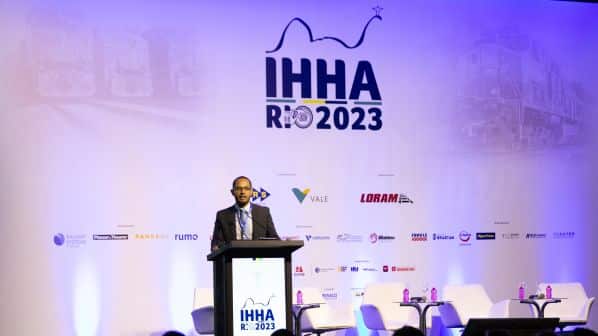BUILDING a new rail line or upgrading an existing corridor is a costly exercise, requiring large amounts of capital investment that can take years to be paid back. For many countries, this can lead to a debate over whether it is better for the public sector to provide most of this investment, or if attracting private investment is a more effective strategy.
This debate is only likely to increase as the need for investment in sustainable transport grows, with a report from the OECD’s International Transport Forum finding that global freight activity is expected to increase by 200% by 2050, largely in emerging economies. This poses challenges to meeting climate change targets, as while only 20% of global emissions are currently attributed to the transport sector, this will increase to 60% by 2050 if no action is taken.
Mr Edpo Covalciuk Silva, a transport specialist with the World Bank, emphasised the critical importance of positioning railways as the cornerstone of the development agenda, particularly in emerging countries, and said there is a danger that these debates could prevent important rail development projects from progressing.
Silva used the examples of projects in Brazil and India, countries where the World Bank is strategically involved in development of transformative rail projects, to show that regardless of whether a private or public model was used, “the most important thing is to place rail as a priority agenda rather than the delivery method.”
India has taken the approach of using a public-led body to tackle its transport issues. The country’s 67,415km rail network now carries 8 billion passengers and 1.15 billion tonnes of freight each year. Yet the network is heavily congested, leading the government to launch its National Rail Plan (NRP) in 2019.
“We must have rail at the centre of the agenda. Rail can increase economic activity, increase logistic efficiencies, and promote economic development while reducing emissions.”
Edpo Covalciuk Silva, a transport specialist with the World Bank
The plan identifies seven high-density corridors and 11 highly-utilised corridors. The high-density corridors represent 16% of the network, totalling 11,000km, while the highly-utilised corridors represent 35% of the network, some 24,230km. At present, 80% of the high-density corridors operate at more than 100% capacity, which means there are more trains than the system can accommodate, while only 2% of the network operates at less than 70% capacity. Of the highly-utilised corridors, 48% are operating at 100% capacity and only 24% are operating below 70% capacity. This results in an average speed of 23.6km/h for freight trains on much of the network, with an estimated two thirds of the network expected to reach 100% capacity by 2051 if no action is taken.
This has resulted in higher costs and commercial unattractiveness, with rail’s freight market share dropping steadily from 88% in 1950-51 to 29% in 2017-18.
The first stage of the project aiming to fix this is the construction of the Eastern and Western Dedicated Freight Corridors (DFC), the former running from Delhi to Kolkata while the later runs from Delhi to Mumbai, both of which are partially operational.
The Eastern DFC is financed by the World Bank, while the Western DFC is financed by the Japan International Cooperation Agency (Jica).
To implement the projects, the Indian government created the Dedicated Freight Corridor Corporation of India (DFCCIL), a special-purpose vehicle (SPV) wholly-owned by Indian Railways (IR). DFCCIL is responsible for implementing and maintaining the infrastructure but will not operate the trains, which will remain the responsibility of IR, or in future private operators.
To govern this relationship between the infrastructure manager and operators, the government granted a 30-year concession agreement. The commercial rules of the agreement are defined by the Minister of Railways, so DFCCIL does not have the autonomy to set the track access charges through which it will be reimbursed.
Brazil
The situation is very different in Brazil. Instead of a large publicly-owned railway, railways are operated by private companies under 13 vertically-integrated concessions awarded by the government, which include the maintenance and expansion of the network.
This has resulted in $US 30bn in private investment in the Brazilian railway network since it was privatised in the 1990s. “In the Brazilian environment this would be impossible without the private sector,” Silva says.
The Brazilian model has room for improvement, such as addressing concerns over interoperability and the standardisation of signalling and telecommunication systems. The World Bank, in collaboration with the Ministry of Transport, has undertaken a study to identify opportunities for more effective regulation and standardisation that can lead to improved interoperability and operational efficiency. Through the International Finance Corporation (IFC), the World Bank has also been involved in the development of two projects seeking to maximise the effectiveness of Brazil’s recently-completed North-South Railway, the 1527km West-East Integration Railway (Fiol) running from Figueirópolis on the North-South Railway to Porto Sul on the Atlantic, and the 1641km Centre-West Integration Railway (Fico) that would run from Mara Rosa on the North-South Railway to Vilhena in northwestern Brazil. These projects would make it possible to transport freight from the centre of Brazil to ports on the country’s north and east coasts.
While the approaches taken by Brazil and India are quite different, Silva says they both show that rail can have a major impact. “We must have rail at the centre of the agenda,” he says. “Rail can increase economic activity, increase logistic efficiencies, and promote economic development while reducing emissions.
“The discussion of private and public models is a valid discussion, it’s an important discussion, but it is only the second step. The first step is to have the rail at the centre of the development agenda and then we can discuss how we deliver it better. And there is no one size fits all solution. Both the public and the private can deliver good results.”

